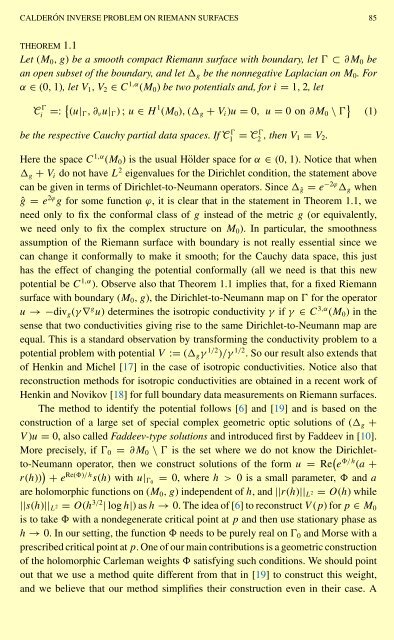NEAR OPTIMAL BOUNDS IN FREIMAN'S THEOREM
NEAR OPTIMAL BOUNDS IN FREIMAN'S THEOREM
NEAR OPTIMAL BOUNDS IN FREIMAN'S THEOREM
You also want an ePaper? Increase the reach of your titles
YUMPU automatically turns print PDFs into web optimized ePapers that Google loves.
CALDERÓN <strong>IN</strong>VERSE PROBLEM ON RIEMANN SURFACES 85<br />
<strong>THEOREM</strong> 1.1<br />
Let (M0,g) be a smooth compact Riemann surface with boundary, let Ɣ ⊂ ∂M0 be<br />
an open subset of the boundary, and let g be the nonnegative Laplacian on M0.For<br />
α ∈ (0, 1),letV1,V2 ∈ C1,α (M0) be two potentials and, for i = 1, 2,let<br />
C Ɣ<br />
i =: (u|Ɣ,∂νu|Ɣ); u ∈ H 1 (M0), (g + Vi)u = 0, u = 0on∂M0 \ Ɣ <br />
(1)<br />
be the respective Cauchy partial data spaces. If C Ɣ 1 = C Ɣ 2 ,thenV1 = V2.<br />
Here the space C1,α (M0) is the usual Hölder space for α ∈ (0, 1). Notice that when<br />
g + Vi do not have L2 eigenvalues for the Dirichlet condition, the statement above<br />
can be given in terms of Dirichlet-to-Neumann operators. Since ˆg = e−2ϕg when<br />
ˆg = e2ϕg for some function ϕ, it is clear that in the statement in Theorem 1.1, we<br />
need only to fix the conformal class of g instead of the metric g (or equivalently,<br />
we need only to fix the complex structure on M0). In particular, the smoothness<br />
assumption of the Riemann surface with boundary is not really essential since we<br />
can change it conformally to make it smooth; for the Cauchy data space, this just<br />
has the effect of changing the potential conformally (all we need is that this new<br />
potential be C1,α ). Observe also that Theorem 1.1 implies that, for a fixed Riemann<br />
surface with boundary (M0,g), the Dirichlet-to-Neumann map on Ɣ for the operator<br />
u →−divg(γ ∇gu) determines the isotropic conductivity γ if γ ∈ C3,α (M0) in the<br />
sense that two conductivities giving rise to the same Dirichlet-to-Neumann map are<br />
equal. This is a standard observation by transforming the conductivity problem to a<br />
potential problem with potential V := (gγ 1/2 )/γ 1/2 . So our result also extends that<br />
of Henkin and Michel [17] in the case of isotropic conductivities. Notice also that<br />
reconstruction methods for isotropic conductivities are obtained in a recent work of<br />
Henkin and Novikov [18] for full boundary data measurements on Riemann surfaces.<br />
The method to identify the potential follows [6] and[19] and is based on the<br />
construction of a large set of special complex geometric optic solutions of (g +<br />
V )u = 0, also called Faddeev-type solutions and introduced first by Faddeev in [10].<br />
More precisely, if Ɣ0 = ∂M0 \ Ɣ is the set where we do not know the Dirichletto-Neumann<br />
operator, then we construct solutions of the form u = Re e/h (a +<br />
r(h)) + eRe()/hs(h) with u|Ɣ0 = 0, where h>0 is a small parameter, and a<br />
are holomorphic functions on (M0,g) independent of h,and||r(h)||L2 = O(h) while<br />
||s(h)||L2 = O(h3/2 | log h|) as h → 0. The idea of [6] to reconstruct V (p) for p ∈ M0<br />
is to take with a nondegenerate critical point at p and then use stationary phase as<br />
h → 0. In our setting, the function needs to be purely real on Ɣ0 and Morse with a<br />
prescribed critical point at p. One of our main contributions is a geometric construction<br />
of the holomorphic Carleman weights satisfying such conditions. We should point<br />
out that we use a method quite different from that in [19] to construct this weight,<br />
and we believe that our method simplifies their construction even in their case. A

















